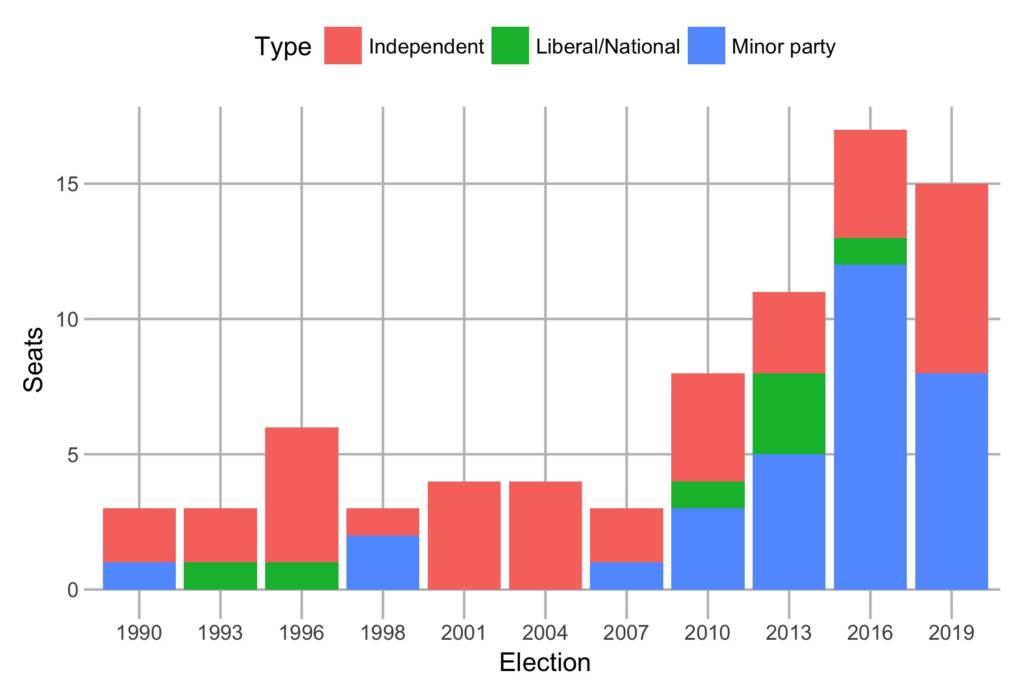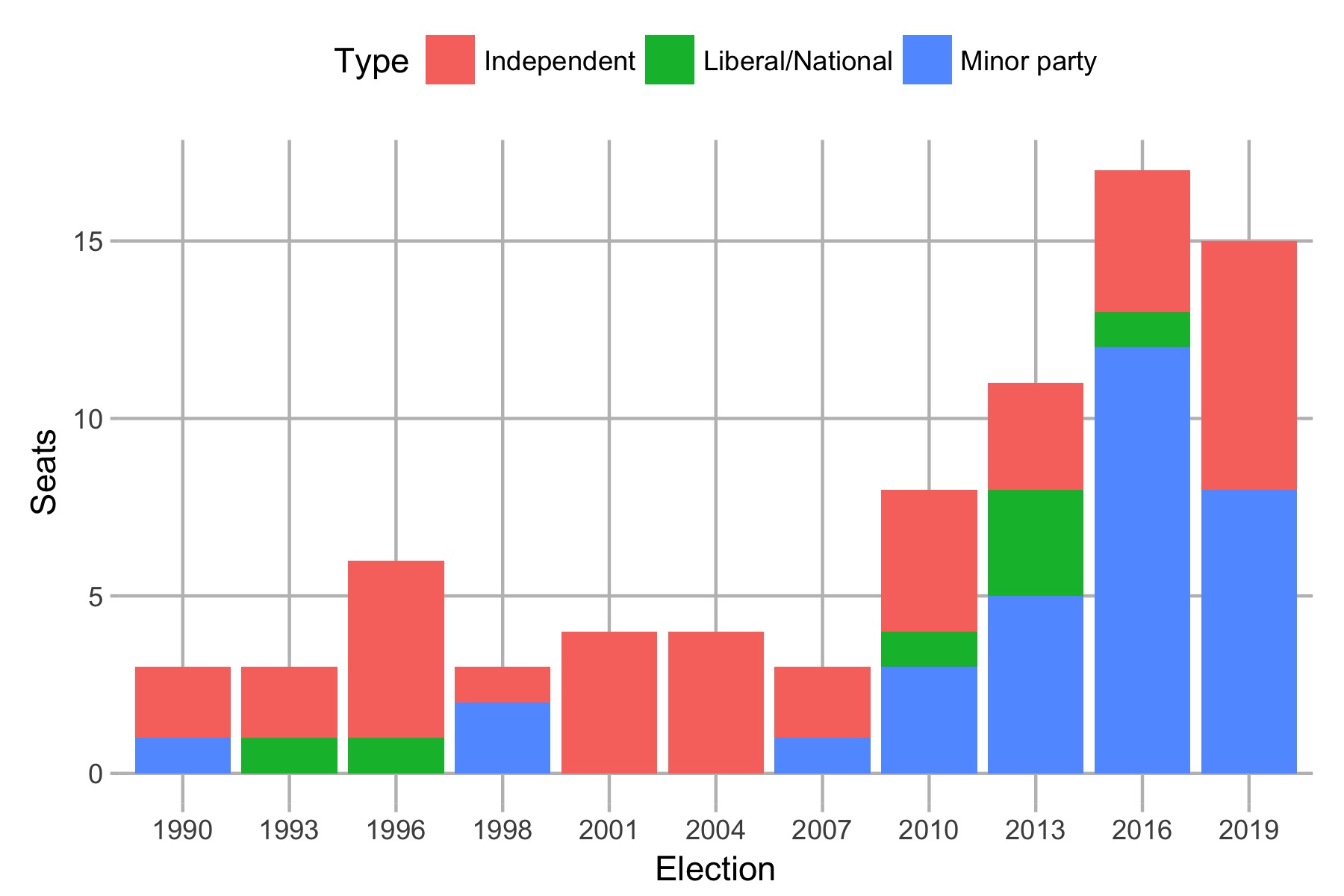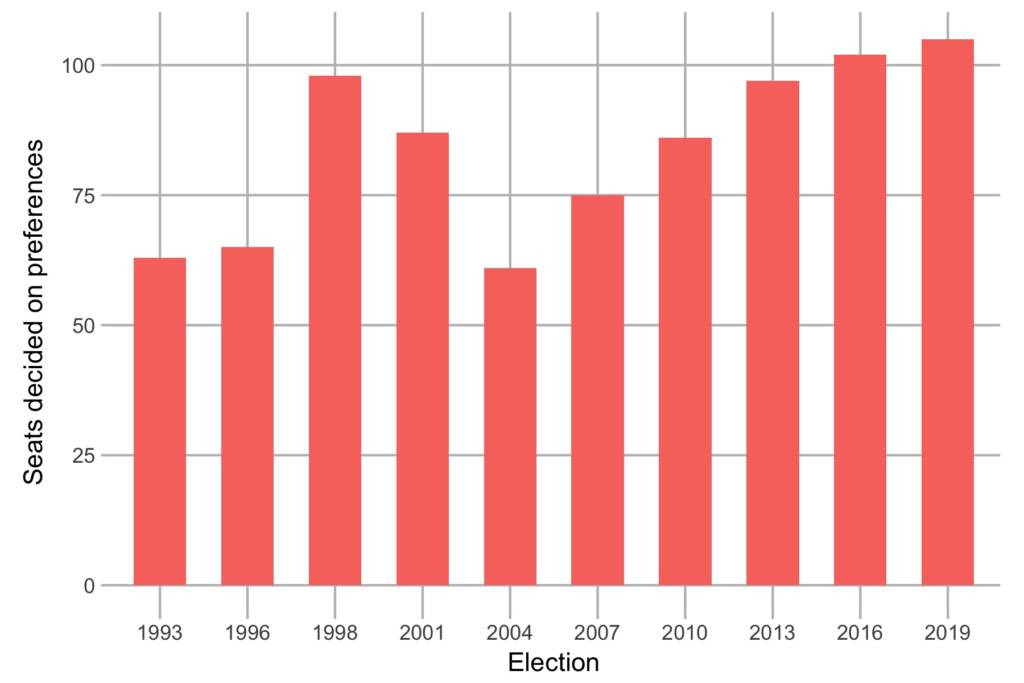This post draws on analysis in my chapter in Morrison’s Miracle, a forthcoming book from ANU Press and Academy of the Social Sciences in Australia about the 2019 federal election.
Most seats in the House of Representatives at the 2019 election were still won by one of the major parties, but below the surface the position of the major parties doesn’t look so dominant.
The major parties polled just 74.8% of the formal vote in the House of Representatives, the lowest figure at any recent election. This was down from 76.8% at the 2016 election, which was already one of the lowest figures.
Most House of Representatives contests have traditionally been races between a Labor candidate and a Coalition candidate, but at a certain point that doesn’t hold up when the major party vote keeps dropping.
We can see that in the “nonclassic” seat count. These are seats where the final matchup was not between Labor and the Coalition. It can include contests between the Liberal and National parties but more commonly involve minor parties or indepenents.

This number peaked at 17 seats out of 150 in 2016 and dropped slightly to 15 out of 151 at the 2019 election. The 2016 count included more minor party candidates, while 2019 featured more independents.
The Nick Xenophon Team made the top two in four seats in 2016, while its successor Centre Alliance just managed one seat in 2019.
New independents came in the top two in 2019 in Cowper, Farrer, New England, Warringah and Wentworth.
This trend can also be seen in a broader range of electorates when you examine the number of seats where preferences were required (ie. seats where no candidate polled a majority of the primary vote).
2016 was the first election where over 100 seats required preferences to decide on a winner, but 2019 went even further.
I don’t think we can assume that this trend of voters moving away from the major parties will continue at the next election, but if it does we’re bound to see more races where the major parties are no longer dominant.





I went through 2019 results looking for electorates that generally get missed in these “where wasn’t it ALP vs Coalition” analyses, what I’d called the “third party marginals.” Of course there’s considerably more volatility in 3rd party vote than there is in 2PP vote, especially when you look at events like NXT 2016, PHON’s random explosive elections, and independents from nowhere, but I chose to define “marginal” in a similar way to how we do it with 2PP, in that if the 3rd party is was within 10% of the party in 2nd the electorate counts as marginal (I also fudged it past this limit to include some seats I think are relevant).
https://docs.google.com/spreadsheets/d/1Q3GKFlJcN8q-rLdd0ctnjtHCWISyyIs6dck_67ZVsE0/edit?usp=sharing
As a pendulum doesn’t really work here I’ve highlighted some electorate I think are actually relevant to the makeup of the HoR if the exclusion order changed. The non-highlighted seats I either think the 1st place party is too far in front or that the 3rd party would get unfavourable preferences from the current 2nd place party so can’t win.
The relevant seats:
Brisbane and Higgins – Very similar 3 cornered races. Coalition with marginal 54.92 and 53.88 2PP and ALP only +1.63 and +1.93 3PP vs GRN, so they could go to the Greens and I expect them to be campaigning to win them in 2022. The rare chance to campaign against a Coalition government hopefully is relished by the Greens.
Hunter – Perhaps the shadow minister for coal snorting has his wits about him with only 52.98 2PP and with the NATs only +1.9 3PP vs PHON. Ones assumes NAT voters would be more disciplined in preferencing against the ALP than PHON voters are.
Macnamara – Really a race for 2nd. The LIB are not well placed to win from 43.75 2PP, but ALP +5.83 3PP over GRN is still competitive. Precedent at state level says it shouldn’t matter who of ALP and Greens comes 2nd, they will win.
Griffith – LNP are close (47.14 2PP) but if GRN continue the rate of colonising the left wing vote here (which would be quite a feat, is there a ceiling for the QLD Greens in inner Brisbane?) they could chase down ALP’s +7 3PP and then win.
Flinders – If ex-Liberal Julia Banks had overtaken ALP’s +9.03 3PP could she have tightened the LIB’s 55.64 2PP on strong preference flows? The lightning has hit the ground in 2019 and can’t strike again, she’s no longer the incumbent, but it’s a data-point for possible future defectors running as independents.
Richmond – Looks like a wide margin but conceivably this is a race for 2nd. ALP are +11.16 over GRN but in 2016 they were only +9.83.
And I forgot the electorate of Blair. Similar deal to Hunter, but would really require an extremely good election for PHON to overtake the +10.46 3PP lead of the LNP.
Mallee’s another one. That had three different pinch points, none of them between first and (who ended up) second.
Starting with the 5cp (yeah really): Nat 31.83, Lib 22.48, ALP 18.74, Modica 13.51, Kingston 13.44.
Kingston excluded by just 65 votes (0.07%).
Then the 4cp: Nat 34.5, Lib 24.10, ALP 20.83, Modica 20.57.
Modica excluded by 248 votes (0.26%).
Then the 3cp: Nat 41.90, ALP 29.23, Lib 28.87
Labor managed to jump the Libs for the first time in the count, and the Lib was excluded by 338 votes (0.36%).
And then the Nat went on to win by a huge margin. If either Modica or Kingston had jumped Labor, they would’ve likely ended up also jumping Labor on Lib preferences and into a (much closer) Nat v Ind 2cp. THe potential Nat v Lib 2cp could also have been closer.
Something like this happened in Melton last Vic election, which had people going “come on, you can’t possibly win from 10% vote / fifth place… wait, can you?” This is preferential voting on hard mode.
Hi Ben
I think that you are reading more into the voting than what there actually exists.
Most minor parties have candidates for the House of Representatives so that they can raise their profile at the the local level. This is so that they can draw votes for the Senate.
However fixed allocation of preferencing for the Senate was changed for the 2016 Federal Election. Since then the influence of minor parties has been negated and will continue to do so.
The effect of this change has not properly filtered down yet. There will be less minor parties elected to the Senate. As a result, minor Party candidates for the House of Representatives will not be required to help elect Senate candidates of the minor parties.
As a result, we are heading back towards a two party system.
As an aside, the Greens only succeed when they can draw off Labor Party preferences for the Senate. This is not always going to be case.
The Greens were lucky at the 2019 Election in that the overall Labor Party primary vote was relatively low. As a result, the left-over Labor Party preferences helped elect the Green Party candidates in the Senate.
However when the Labor Party primary vote improves in the future, the Greens preferences will be drawn back towards Labor and thus help elect the second and third placed Labor Party candidates in the Senate.
The change of preferencing was one of the reasons why our party did not run candidates for the Senate at the 2019 Election.
John Flanagan
Non-Custodial Parents Party (Equal Parenting)
@John Flanagan
Some of what you say is very true. I think we could see a waning of the number of minor parties due to the substantially higher bar to have a chance to get elected in the Senate under the new rules. It is probable that fewer minor party options will drive some voters back to the 2 major parties. However it’s also possible that one “left” (Greens) and one “right” (One Nation/SFF/KAP) is enough on the ballot to absorb most of the market for 3rd party votes. We’ll have to see.
Some of what you say is very wrong though. The Greens did not rely on Labor preferences to win Senate seats, they relied on their own primary vote. If every Labor voter had just voted 1 Labor in the Senate the Greens still would have won there 6 seats. For Labor to overtake and exclude the Greens in Senate races the Greens would need to get substantially weaker primary votes, more like 5% not 10%-12%. Unless you are proposing it is possible for Labor to primary 40% in the Senate, with the Greens on 10%, but then for “the left” to somehow miss out on a 4th seat in that state (Greens stranded in 7th). I don’t think a Labor vote that high is probably, and if it does happen it’s more likely the Greens still come 6th not 7th.
The Senate changes increase the need for minor parties to run House of Reps candidates to maximise both their Senate primary vote and their Senate preferences, as the more known a party, the more able it is to get preferences now they are all directly voter allocated.
The Greens, One Nation, KAP and Jacqie Lambie (who runs with her own party, the Jacqie Lambie Network, to get her name above the line) don`t look like going anywhere anytime soon, leaving us with a 6-7 party system (depending on how you count the Nats).
A similar thing could be true in state parliaments (that have changed the rules, senate-style). The Shooters never used to run in the lower house in NSW, but now they do and they have three seats. Having a few seats where they get 50% (and lots of voters who vote for them in both houses) is about 0.5% per seat across NSW, handy to have with a 4.5% quota.
On party systems: so long as the majors continue to be sufficiently major (getting 2 quotas each), there are effectively four party-slots in any given state in a half-Senate election.
In a half-Senate election of six Senators, the balance is fairly stable. It’s rare that the broad Left or Right will hit four quotas (and this bears out in Reps statewide 2PPs too, I think). Whoever comes closer will be unlucky 7th, and further will be #8.
So any minor party with a clear Wing doesn’t really change the usual pattern: two-three from each of the majors, zero-one from a minor on each side. The competition between PHON, KAP and Palmer in Qld is generally as to who gets that minor-right slot. Qld in 2019 was an aberration in that the broader Right topped 4 quotas.
Centrist-presenting candidates such as Lambie or Hinch take from both majors I suppose. But both being in federally Left states, it’s the LNP #3 who were then left as unlucky 7th.
Hi Bennee
Thank you for your comments.
The following quotas for the Senate for the 6 states were received by the Australian Labor Party and the Greens at the 2019 Federal Election.
NSW – ALP – 2.0876 (2 elected); The Greens – 0.6109 (1 elected)
Victoria – ALP – 2.1787 (2 elected); The Greens – 0.7434 (1 elected)
Queensland – ALP – 1.5797 (1 elected); The Greens – 0.6956 (1 elected).
Western Australia – ALP – 1.9338 (2 elected); The Greens – 0.8268 (1 elected)
South Australia – ALP – 2.1253 (2 elected); the Greens – 0.7639 (1 elected).
Tasmania – ALP – 2.1412 (2 elected); the Greens – 0.8797 (1 elected).
Six (6) Greens candidates were elected to the Senate. However none of these candidates received a full quota at the primary vote stage. They all relied on Australian Labor Party preferences. Had the Australian Labor Party had received a much bigger primary vote, then less of these Greens candidates would have been elected.
At a future election, there is potential for none of these six (6) Greens candidates being elected.
That is why, I think that we are heading towards a two party system.
Just to be clear, I am challenging the assertion that “left-over Labor Party preferences helped elect the Green Party candidates in the Senate.”
Look at the size of the ALP surpluses. None of them were large enough to have changed the outcome.
0.0876 quotas in ALP surplus in NSW. That’s a much smaller number than 0.4539, which represents Mehreen Faruqi’s quota lead over One Nation when there were 7 candidates left in the count. All one and a half million ALP voters in NSW could have preferences One Nation 2nd and Mehreen Faruqi would be in the senate right now.
0.1787 ALP surplus in VIC. When there were 9 candidates left in the count the Greens were in 5th place and on 0.9766 quotas. Mathematically victory was assured as 0.2907 quotas had already exhausted at this point. The next to exclude was indeed the last remaining Labor candidate, the preferences of which put Janet Rice over a quota, but you must certainly agree that she would have won no matter how ALP voters preferenced.
Labor preferences were never thrown in QLD. With 7 candidates left Labor was stranded in 7th on 0.7681 quotas, the Greens on 0.9579 quotas and therefore Larissa Waters was elected in 6th. All 650,000 ALP voters in QLD could have put the Greens last and Larissa Waters would be a senator right now.
There were effectively zero ALP surplus in WA as they started short of 2 quotas. It didn’t matter, when there were 7 candidates remaining Jordon Steele-John was in 6th and a whopping 0.4087 quotas ahead of One Nation in 7th.
In SA Sarah Hanson-Young was elected due to having 1.060 quotas when there were 9 candidates remaining. If you minus Labor’s 0.1253 surplus from that she would be short of a quota! But alas 0.0577 quotas had already exhausted, there was no room for her to be chased down pretty much no matter what.
In Tasmania Nick McKim was elected in 4th place while 2 Labor candidates were still in the count! Clearly he did not need ALP preferences.
So what is the mistake you are making? You seem to be assuming that because Labor get a lot of primary votes that their voter’s preferences must be very influential on the make up of the senate. This could not be further from the truth. Preferences from the Labor and Coalition matter THE LEAST of all the parties in the senate (well, I guess you could say the Greens preferences matter even less given pretty much zero Green preferences were counted at all). What really mattered to the Greens? Their primary vote relative to the other parties in the mix for 6th place (One Nation and sometimes the 3rd Coalition or 2nd or 3rd ALP candidate), favourable and disciplined preferences from the HEMP and Animal Justice micro-parties, and the relative ill-discipline of preferences from unfavourable micro-parties like UAP, LD, and DLP. An important concept is that it is not a race to 1.000 quotas for the Greens, so long as their goal is to win 1 seat in a state, they merely need to be in 6th when there are 7 candidates remaining which can theoretically be quite likely even from quite low primary votes (0.6 quotas?).
Comments are closed.